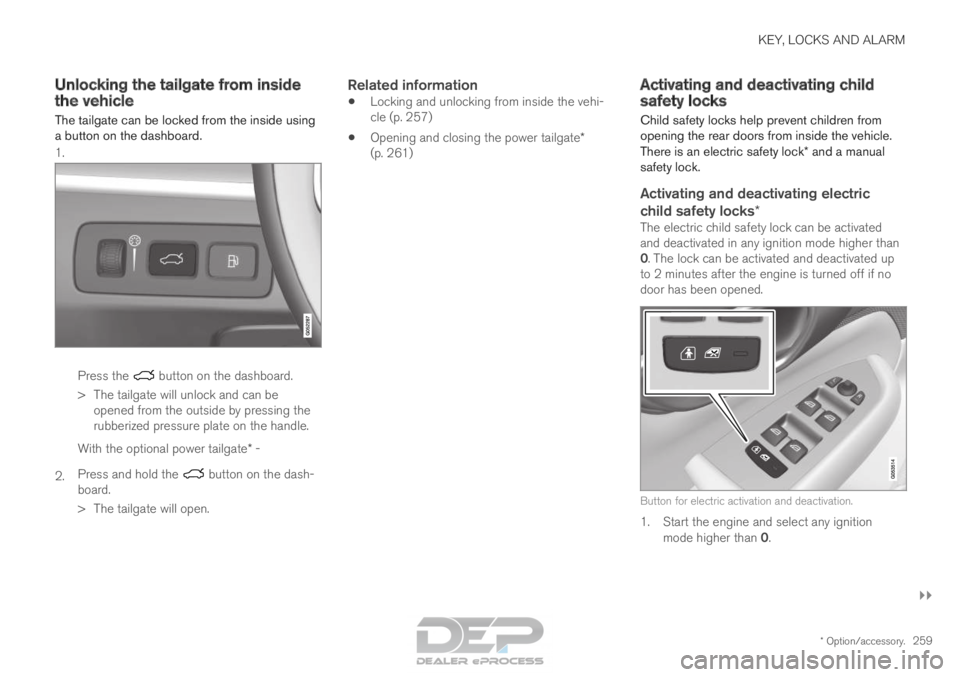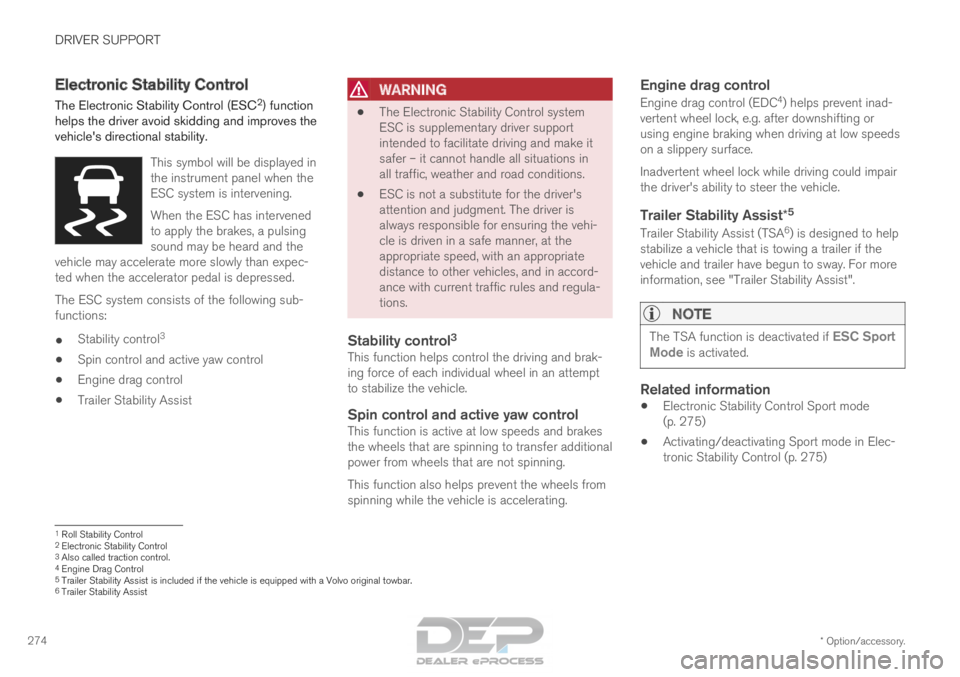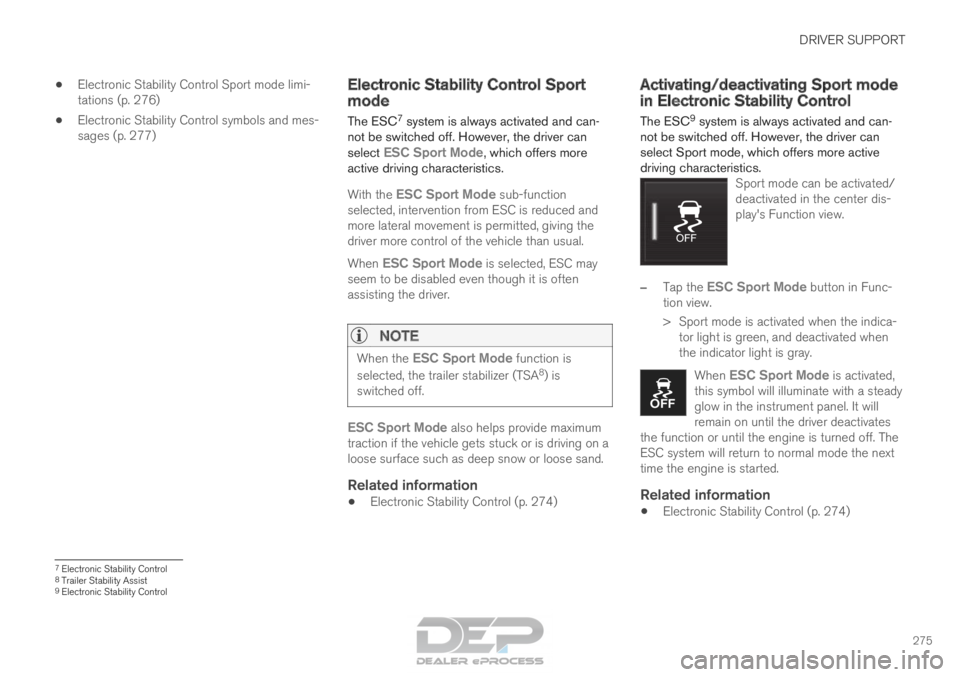engine VOLVO XC90 TWIN ENGINE 2018 Workshop Manual
[x] Cancel search | Manufacturer: VOLVO, Model Year: 2018, Model line: XC90 TWIN ENGINE, Model: VOLVO XC90 TWIN ENGINE 2018Pages: 686, PDF Size: 17 MB
Page 261 of 686

KEY, LOCKS AND ALARM
}}
* Option/accessory. 259
Unlocking the tailgate from inside
the vehicle
The tailgate can be locked from the inside using
a button on the dashboard. 1. Press the button on the dashboard.
>
The tailgate will unlock and can be
opened from the outside by pressing the
rubberized pressure plate on the handle.
2. With the optional power tailgate* -
Press and hold the button on the dash-
board.
>
The tailgate will open.
Related information
• Locking and unlocking from inside the vehi-
cle (p. 257)
• Opening and closing the power tailgate*
(p. 261) Activating and deactivating child
safety locks
Child safety locks help prevent children from
opening the rear doors from inside the vehicle.
There is an electric safety lock* and a manual
safety lock.
Activating and deactivating electric
child safety locks*
The electric child safety lock can be activated
and deactivated in any ignition mode higher than
0. The lock can be activated and deactivated up
to 2 minutes after the engine is turned off if no
door has been opened. Button for electric activation and deactivation.
1. Start the engine and select any ignition
mode higher than 0.
Page 262 of 686

||KEY, LOCKS AND ALARM
260
2. Press the button on the driver's door control
panel.
>The message Rear child lock Activated
will be shown in the instrument panel and
the indicator light will illuminate to show
that the child safety locks are activated.
When the electric child safety locks are activated:
• the rear windows can only be opened using
the driver's door control panel
• the rear doors cannot be opened from the
inside.
To deactivate the child safety locks:
– Press the button on the driver's door control
panel.
>
The message Rear child lock
Deactivated will be shown in the instru-
ment panel and the indicator light will go
out to show that the child safety locks are
deactivated.
When the engine is turned off, the current setting
will be saved. If the locks were activated when
the engine was turned off, they will remain acti-
vated the next time the engine is started. Symbol
Message Meaning Rear child
lock Acti-
vated The child safety
locks are acti-
vated. Rear child
lock Deacti-
vated The child safety
locks are deacti-
vated.
Activating and deactivating manual
child safety locks Manual child safety lock (this is not the manual door
lock).
–
Use the detachable key blade in the remote
key to turn the control. The door cannot be opened from the inside.
The door can be opened from both the out-
side and the inside.
NOTE •
The door's knob control only locks that
specific door, not both rear doors simulta-
neously.
• There are no manual child safety locks on
models equipped with electronic child
safety locks.
Related information
•Locking and unlocking from inside the vehi-
cle (p. 257)
• Detachable key blade (p. 250)
Page 275 of 686

DRIVER SUPPORT
* Option/accessory.273
WARNINGWhile the power steering is working at
reduced power, the driver support functions
with steering assistance are not available.
In such a situation, the driver display shows
the
Power steering failure or Power
Steering Assist Temporarily Reduced message, combined with a STEERING
WHEEL symbol.
Changing the level of steering wheel
resistance*
To change the level of steering wheel resistance,
see the description of the INDIVIDUAL option
under "Available drive modes" in the "Drive
modes" section.
On models not equipped with drive mode con-
trols and the INDIVIDUAL option, steering wheel
resistance can instead be set in the center dis-
play's Top view under:
Settings My Car Drive Modes
Steering force
Steering wheel resistance settings cannot be
accessed when turning at speeds above
10 km/h (6 mph).
Related information
•
Drive modes (p. 445)
• Pilot Assist (p. 311) •
Lane Keeping Aid (p. 364)
• Steering assistance at risk of collision
(p. 372)
• Park Assist Pilot* (p. 395) Stability system Roll Stability
Control
The Roll Stability Control (RSC 1
) system helps
minimize the risk of a rollover in the event of e.g.
a sudden evasive maneuver or if the vehicle
begins to skid.
The RSC system monitors the lateral angle at
which the vehicle is leaning and registers any
changes. Using this information, the system cal-
culates the likelihood of a rollover. If there is an
imminent risk of a rollover, Electronic Stability
Control is activated, engine torque is reduced and
brakes are applied to one or more of the wheels
until the vehicle has regained stability.
WARNING The vehicle
Page 276 of 686

DRIVER SUPPORT
* Option/accessory.
274 Electronic Stability Control
The Electronic Stability Control (ESC 2
) function
helps the driver avoid skidding and improves the
vehicle's directional stability.
This symbol will be displayed in
the instrument panel when the
ESC system is intervening.
When the ESC has intervened
to apply the brakes, a pulsing
sound may be heard and the
vehicle may accelerate more slowly than expec-
ted when the accelerator pedal is depressed. The ESC system consists of the following sub-
functions:
•
Stability control 3
• Spin control and active yaw control
• Engine drag control
• Trailer Stability Assist
WARNING •
The Electronic Stability Control system
ESC is supplementary driver support
intended to facilitate driving and make it
safer – it cannot handle all situations in
all traffic, weather and road conditions.
• ESC is not a substitute for the driver's
attention and judgment. The driver is
always responsible for ensuring the vehi-
cle is driven in a safe manner, at the
appropriate speed, with an appropriate
distance to other vehicles, and in accord-
ance with current traffic rules and regula-
tions.
Stability control 3This function helps control the driving and brak-
ing force of each individual wheel in an attempt
to stabilize the vehicle.
Spin control and active yaw controlThis function is active at low speeds and brakes
the wheels that are spinning to transfer additional
power from wheels that are not spinning.
This function also helps prevent the wheels from
spinning while the vehicle is accelerating.
Engine drag control
Engine drag control (EDC
4
) helps prevent inad-
vertent wheel lock, e.g. after downshifting or
using engine braking when driving at low speeds
on a slippery surface.
Inadvertent wheel lock while driving could impair
the driver's ability to steer the vehicle.
Trailer Stability Assist* 5
Trailer Stability Assist (TSA
6
) is designed to help
stabilize a vehicle that is towing a trailer if the
vehicle and trailer have begun to sway. For more
information, see "Trailer Stability Assist".
NOTE The TSA function is deactivated if
ESC Sport
Mode is activated.
Related information
• Electronic Stability Control Sport mode
(p. 275)
• Activating/deactivating Sport mode in Elec-
tronic Stability Control (p. 275) 1
Roll Stability Control
2 Electronic Stability Control
3 Also called traction control.
4 Engine Drag Control
5Trailer Stability Assist is included if the vehicle is equipped with a V\
olvo original towbar.6 Trailer Stability Assist
Page 277 of 686

DRIVER SUPPORT
275
•
Electronic Stability Control Sport mode limi-
tations (p. 276)
• Electronic Stability Control symbols and mes-
sages (p. 277) Electronic Stability Control Sport
mode
The ESC 7
system is always activated and can-
not be switched off. However, the driver can
select ESC Sport Mode, which offers more
active driving characteristics.
With the
ESC Sport Mode sub-function
selected, intervention from ESC is reduced and
more lateral movement is permitted, giving the
driver more control of the vehicle than usual.
When ESC Sport Mode is selected, ESC may
seem to be disabled even though it is often
assisting the driver.
NOTE When the
ESC Sport Mode function is
selected, the trailer stabilizer (TSA 8
) is
switched off. ESC Sport Mode also helps provide maximum
traction if the vehicle gets stuck or is driving on a
loose surface such as deep snow or loose sand.
Related information
• Electronic Stability Control (p. 274) Activating/deactivating Sport mode
in Electronic Stability Control
The ESC
9
system is always activated and can-
not be switched off. However, the driver can
select Sport mode, which offers more active
driving characteristics. Sport mode can be activated/
deactivated in the center dis-
play's Function view. –
Tap the
ESC Sport Mode button in Func-
tion view.
>
Sport mode is activated when the indica-
tor light is green, and deactivated when
the indicator light is gray.
When ESC Sport Mode is activated,
this symbol will illuminate with a steady
glow in the instrument panel. It will
remain on until the driver deactivates
the function or until the engine is turned off. The
ESC system will return to normal mode the next
time the engine is started.
Related information
• Electronic Stability Control (p. 274) 7
Electronic Stability Control
8 Trailer Stability Assist
9 Electronic Stability Control
Page 279 of 686

DRIVER SUPPORT
277
Electronic Stability Control symbols
and messages
A number of symbols and messages related to
Electronic Stability Control (ESC) may be dis-
played in the instrument panel. Some examples of symbols and messages are
shown in the table below.Symbol
Message MeaningSteady glow for
approx. 2 seconds.
System check when the engine is started.Flashing light.
The ESC is actively operating.Steady glow.
Sport mode is activated.
Note: The ESC system is not deactivated in this mode, but has partially reduc\
ed functionality. ESC
Temporarily off
The ESC system's functionality has been temporarily reduced due to hi\
gh brake system temperatures. The
function will be automatically reactivated when the brakes have cooled.
See the message in the instrument panel.ESC
Service required
The ESC system is not functioning properly.
• Stop the vehicle in a safe place, turn off the engine and then restart i\
t.
• Consult a workshop if the message persists ‒ an authorized Volvo workshop is recommended. A text message can be erased by briefly pressing
the
button in the center of the right-side
steering wheel keypad. If the message persists: Contact a workshop ‒ an
authorized Volvo workshop is recommended.
Related information
• Electronic Stability Control (p. 274)
Page 281 of 686

DRIVER SUPPORT
}}
279
Activating and starting Speed
Limiter
The Speed Limiter (SL 13
) function must be
selected and activated in order to regulate
speed.
Putting Speed Limiter in standby mode Note: This illustration is general and details may vary
depending on model.
–
Press ◀ (1) or ▶ (3) and scroll to the Speed
Limiter function (4).
>
The symbol (4) will appear, indicating that
the Speed Limiter is in standby mode.
Starting the Speed LimiterThe Speed Limiter can only be activated while
the engine is running. The lowest maximum
speed that can be set is 30 km/h (20 mph). –
With the Speed Limiter in standby mode and
the symbol displayed, press the
button (2) on the steering wheel key-
pad.
>
The Speed Limiter will be started and the
vehicle's current speed will be set as the
maximum speed.
Related information
• Speed limiter (p. 278) Managing Speed Limiter speed
The Speed Limiter (SL
14
) can be set to various
speeds.
Setting/changing set speed Note: This illustration is general and details may vary
depending on model.
–
Change a set speed by pressing the (1)
or (3) buttons briefly or by pressing and
holding them:
• Press briefly: Press briefly: each press
changes the speed in +/- 5 mph
(+/- 5 km/h) increments.
• Press and hold: Release the button when
the set speed indicator (4) has moved to
the desired speed.
• The most recently set speed will be stored. 13
Speed Limiter
Page 290 of 686

DRIVER SUPPORT
288Managing Cruise Control speed
Cruise Control (CC 29
) can be set to various
speeds.
Setting/changing set speed Note: This illustration is general and details may vary
depending on model.
For vehicles with only CC
–
Change a set speed by pressing the (1)
or (3) buttons briefly or by pressing and
holding them:
• Press briefly: Press briefly: each press
changes the speed in +/- 1 mph
(+/- 1 km/h) increments.
• Press and hold: Release the button when
the set speed indicator (4) has moved to
the desired speed. •
The most recently set speed will be stored.
If speed is increased by depressing the accelera-
tor pedal while pressing the (1) button on
the steering wheel, the vehicle's speed when the
button is pressed will be stored as the set speed.
Temporarily increasing speed using the accelera-
tor pedal, e.g. when passing another vehicle, will
not affect the setting. The vehicle will return to
the set speed when the accelerator pedal is
released.
For vehicles with both CC and ACC
– Change a set speed by pressing the (1)
or (3) buttons briefly or by pressing and
holding them:
• Press briefly: Press briefly: each press
changes the speed in +/- 5 mph
(+/- 5 km/h) increments.
• Press and hold: Release the button when
the set speed indicator (4) has moved to
the desired speed.
• The most recently set speed will be stored.
If speed is increased by depressing the accelera-
tor pedal while pressing the (1) button on
the steering wheel, the vehicle's speed when the
button is pressed will be stored as the set speed.
Temporarily increasing speed using the accelera-
tor pedal, e.g. when passing another vehicle, will not affect the setting. The vehicle will return to
the set speed when the accelerator pedal is
released.
Using engine braking instead of
applying the brakes
Cruise Control regulates speed by lightly applying
the brakes. On downgrades, it can sometimes be
desirable to roll a bit faster and let speed be
reduced instead by engine braking alone. The
driver can temporarily disengage the Cruise Con-
trol braking function.
To disengage CC:
– Press the accelerator pedal about halfway
down and then release it.
>
Cruise Control will automatically disen-
gage the automatic brake function and
speed will only be reduced using the
engine braking function.
How drive mode affects cruise controlThe way the cruise control maintains the vehicle's
speed can vary depending on the selected drive
mode 30
. 29
Cruise Control
30 For more information, see "Drive modes".
Page 291 of 686

DRIVER SUPPORT
289
Cruise Control Eco Cruise
In the ECO drive mode, cruise control's accelera-
tion and deceleration will be smoother than in
other drive modes to help provide optimal fuel
efficiency and reduced environmental impact.
Because of this, the vehicle's actual speed may
be slightly above or below the set speed.
Cruise Control Dynamic Cruise
With the Dynamic drive mode, cruise control's
acceleration and deceleration will be faster and
more immediate than in other drive modes.
Related information
•Cruise control (p. 286) Deactivating and putting Cruise
Control in standby mode
Cruise Control (CC 31
) can be temporarily put
into standby mode and then reactivated.
Deactivating and putting Cruise Control
in standby mode Note: This illustration is general and details may vary
depending on model.
To put Cruise Control in standby mode:
–
Press the button on the steering wheel
(2).
>
The Cruise Control markings and symbols
will change from WHITE to GRAY, indicat-
ing that Cruise Control is temporarily
deactivated and the driver needs to con-
trol the vehicle's speed.
Standby mode due to action by the driver
Cruise Control will be temporarily deactivated and
put in standby mode if:
• the brakes are applied
• the gear selector is moved to N
• the vehicle is driven faster than the set
speed for more than 1 minute
The driver must then control the vehicle's speed.
Temporarily increasing speed using the accelera-
tor pedal, e.g. when passing another vehicle, will
not affect the setting. The vehicle will return to
the set speed when the accelerator pedal is
released.
Automatic standby mode
Cruise Control will be temporarily deactivated and
put in standby mode if:
• the wheels lose traction
• the engine speed (rpm) is too low/high
• the temperature in the brake system
becomes too high
• the vehicle's speed goes below 30 km/h
(20 mph).
The driver must then control the vehicle's speed.
Related information
• Cruise control (p. 286) 31
Cruise Control
Page 295 of 686

DRIVER SUPPORT
}}
* Option/accessory. 293
NOTEVisual warnings on the windshield may be dif-
ficult to notice in cases of strong sunlight,
reflections, extreme light contrasts, or if the
driver is wearing sunglasses or is not looking
straight ahead.
Related information
•
Distance Alert* (p. 291)
• Head-up display* (p. 142) Activating/deactivating Distance
Alert
38
It is possible to set time intervals for Distance
Alert or to turn the function off.
On/OffPress the Distance Alert but-
ton in the center display's
Function view. •
GREEN button indicator light - Distance Alert
is on.
• GRAY button indicator light - Distance Alert
is off.
Distance Alert is automatically activated each
time the engine is started.
Related information
• Distance Alert* (p. 291) Setting a time interval for Distance
Alert
39
The Distance Alert function can be set to differ-
ent time intervals. Different time intervals to the
vehicle ahead can be selected
and are shown in the instru-
ment panel as 1–5 horizontal
bars. The more bars, the longer
the time interval. One bar rep-
resents an interval of
approx. 1 second to the vehicle ahead. 5 bars
represents approx. 3 seconds. The same symbol appears when the Adaptive
Cruise Control function is activated.
38
The Distance Alert function is only available in vehicles that can displ\
ay information on the windshield with a head-up display.
39 The Distance Alert function is only available in vehicles that can displ\
ay information on the windshield with a head-up display.